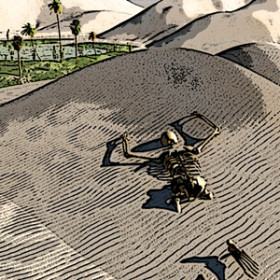There’s No Accounting For Taste.
Chapter Two, Part Four.
 Imagine you’re sitting at a desert resort when you spot a man dragging his haggard body across the sand. The tattered remains of his clothes cling to his emaciated body. His face is covered by a week-old beard. He looks up at you pleadingly.
Imagine you’re sitting at a desert resort when you spot a man dragging his haggard body across the sand. The tattered remains of his clothes cling to his emaciated body. His face is covered by a week-old beard. He looks up at you pleadingly.
“Good Lord man!” you cry. “You must be thirsty. Here, have some wine!”
In a raspy voice he croaks, “How many points did it score?”
Now I don’t want to get off on a rant about the wine rating system, but have you ever noticed that a wine that tastes great to The Wine Spectator or The Wine Advocate doesn’t always taste so great to you? Why do these publications sometimes give a 94 point rating to a wine you wouldn’t serve a dying man at a desert oasis?
Look, you’re a grownup; by now you should realize an “outstanding” 94-point rating for a bottle of Gewurztraminer is personally meaningless if you don’t like the flavor of Gewurztraminer. I mean did you fall for it when your mom told you the brussel sprouts were rated 94 points?
When analyzing wine you need to distinguish between what physiologically happens between your cheeks and what psychologically happens between your ears. One is a bodily sensation while the other is a personal judgment or an opinion. YourDictionary.com defines taste as, “a liking, inclination, fondness.” If you don’t have a liking for, an inclination towards, or a fondness of Gewurztraminer you won’t like the way it tastes even if it scores 200 points (a very real possibility in The Wine Enthusiast).
Taste preferences are programmed into your brain by your personal upbringing, the region you come from, cultural background and psychological experiences. There’s no right or wrong answer regarding what you do or don’t like, it’s simply a matter of taste. Let’s face it, the only people who have seriously bad taste in wine are those who disagree with you and me.
I meet loads of people who are so caught up in the ratings game that they don’t even consider their own personal likes and dislikes when buying wine. If you disagree with a wine critic’s opinion, more power to you! Start a blog, start a movement or start your own wine magazine, but if you live near Marvin Shanken, have someone else start your car.
I’ve been writing about looking at, or listening to wine throughout this chapter but eventually it’s time to stop all the foreplay and embrace the taste. When you drink, gustation works hand in hand with your other senses to perceive flavor. Your tongue, the roof of your mouth and the lining of your throat are covered by gustatory cells that act as taste receptors. These gustatory taste receptors are more commonly known as taste buds. Really, I’m not making it up this time.
Just about every book I’ve read concerning wine talks about particular areas of the tongue that are earmarked to identify specific flavors. What I would like to know is, can a tongue really be earmarked?
Inevitably these writings are accompanied by some absurd drawing of a tongue. Oddly enough, I never taste specific flavors on any particular part of my tongue. I do feel textures in specific locations in my mouth but to my knowledge a tongue texture map hasn’t been created. Thank God. I think I’d toss my Tannat if I had to put up with two of those absurd drawings.
For years I tried to taste sweet flavors at the tip of my tongue and bitter flavors on the back of my tongue but to no avail. I thought there was something wrong with my palate, and I logically assumed I had done it irreparable damage from years of sticking my foot in my mouth. As it turns out, there is nothing wrong with my tongue that isn’t cured by a swift kick under the table from my wife.
The National Institutes of Health writes, “A common misconception is that taste cells that respond to different tastes are found in separate regions of the tongue. In humans, the different types of taste cells are scattered throughout the tongue.”[1] Finally I can sleep at night knowing I don’t have a perceptually challenged palate, but more importantly, I don’t have to put that lame drawing of a tongue in my blog.
[1] http://www.nidcd.nih.gov/health/smelltaste/pages/taste.aspx.





















Hi Don,
And check out this recent research on the human nose!
http://www.npr.org/blogs/health/2014/03/20/291954994/never-mind-eyesight-your-nose-knows-much-more
Cheers!
A trillion aromas – Olfaction is like the national debt of our senses!
Yes, I’m working right now on updating my map of the human nose. I’ve started by marking the 46 billion neurons sensitive to Cabs. They will be in various shades of red, each subtly hued to reflect soil type and the species of oak used in the barreling. Will get the first draft to you early next week.
Cheers,